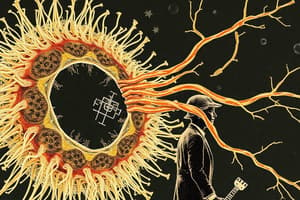Podcast
Questions and Answers
What role does clathrin play in cellular processes?
What role does clathrin play in cellular processes?
- Maintains the shape of vesicles and directs them to their destination (correct)
- Enhances the rigidity of the nuclear membrane
- Synthesizes lipids for the cell membrane
- Facilitates the breakdown of glucose molecules
Which of the following accurately describes the structure of clathrin?
Which of the following accurately describes the structure of clathrin?
- Consists of a single heavy chain and a single light chain
- Made up of four distinct polypeptide units
- Comprised of three heavy chains and three light chains arranged in a triskelion (correct)
- Formed by a double helix of proteins
What is the primary purpose of endocytosis?
What is the primary purpose of endocytosis?
- To regulate metabolic pathways
- To initiate apoptosis in damaged cells
- To increase cell replication rate
- To transport macromolecules and maintain membrane balance (correct)
Which statement correctly describes LDL's function in relation to endocytosis?
Which statement correctly describes LDL's function in relation to endocytosis?
What is a main consequence of improper endocytosis?
What is a main consequence of improper endocytosis?
Which type of endocytosis primarily involves clathrin-coated pits?
Which type of endocytosis primarily involves clathrin-coated pits?
How does clathrin contribute to cellular waste disposal?
How does clathrin contribute to cellular waste disposal?
What is one of the critical roles of membrane maintenance during endocytosis?
What is one of the critical roles of membrane maintenance during endocytosis?
Which statement accurately describes the role of LDL in the bloodstream?
Which statement accurately describes the role of LDL in the bloodstream?
What outcome follows the internalization of LDL particles into vesicles?
What outcome follows the internalization of LDL particles into vesicles?
Which of the following represents a continuous process related to the function of LDL?
Which of the following represents a continuous process related to the function of LDL?
What is the primary function of the vesicle containing internalized LDL?
What is the primary function of the vesicle containing internalized LDL?
In what way do Low-Density Lipoproteins (LDL) primarily interact with cells?
In what way do Low-Density Lipoproteins (LDL) primarily interact with cells?
What is the main component that defines an LDL particle?
What is the main component that defines an LDL particle?
What role does clathrin play in the formation of LDL particles?
What role does clathrin play in the formation of LDL particles?
After losing its clathrin coat, what is the next step for an LDL particle?
After losing its clathrin coat, what is the next step for an LDL particle?
Which protein is critical for the structure of LDL particles?
Which protein is critical for the structure of LDL particles?
In the context of LDL particle formation, what does the term 'receptor-mediated endocytosis' refer to?
In the context of LDL particle formation, what does the term 'receptor-mediated endocytosis' refer to?
Which of the following lipids is NOT a component of an LDL particle?
Which of the following lipids is NOT a component of an LDL particle?
What occurs to the clathrin-coated vesicle during the endocytosis of LDL?
What occurs to the clathrin-coated vesicle during the endocytosis of LDL?
Which of the following best describes the structure of LDL particles?
Which of the following best describes the structure of LDL particles?
What initiates the process of vesicle formation at the plasma membrane?
What initiates the process of vesicle formation at the plasma membrane?
Which component is primarily responsible for the coated structure of the vesicle during its formation?
Which component is primarily responsible for the coated structure of the vesicle during its formation?
During vesicle formation, what happens to the membrane after the ligand has bound to its receptor?
During vesicle formation, what happens to the membrane after the ligand has bound to its receptor?
What is the outcome of the membrane invagination process?
What is the outcome of the membrane invagination process?
What role does the clathrin-coated pit play in cellular transport?
What role does the clathrin-coated pit play in cellular transport?
What is a critical feature of clathrin-coated vesicles?
What is a critical feature of clathrin-coated vesicles?
What process primarily depends on the specific binding of ligands to receptors for vesicle formation?
What process primarily depends on the specific binding of ligands to receptors for vesicle formation?
Which event directly follows ligand-receptor binding in the vesicle formation process?
Which event directly follows ligand-receptor binding in the vesicle formation process?
What is the primary function of clathrin-coated vesicles?
What is the primary function of clathrin-coated vesicles?
Which process is associated with the release of histamine by mast cells?
Which process is associated with the release of histamine by mast cells?
What triggers the process of regulated exocytosis?
What triggers the process of regulated exocytosis?
What is a phagosome?
What is a phagosome?
What is the role of LDL in cellular processes?
What is the role of LDL in cellular processes?
What cellular response is triggered by the release of histamine?
What cellular response is triggered by the release of histamine?
Which mechanism is primarily involved in engulfing large particles by immune cells?
Which mechanism is primarily involved in engulfing large particles by immune cells?
The process by which cellular contents are released to the external environment primarily involves what?
The process by which cellular contents are released to the external environment primarily involves what?
What role do antibodies, lectins, and complement proteins play in the immune system?
What role do antibodies, lectins, and complement proteins play in the immune system?
Which type of vesicles is responsible for transporting materials from the Golgi to the Endoplasmic Reticulum?
Which type of vesicles is responsible for transporting materials from the Golgi to the Endoplasmic Reticulum?
What is the third stage of phagocytosis following particle adhesion and ingestion?
What is the third stage of phagocytosis following particle adhesion and ingestion?
What is the primary function of COP II vesicles in cellular transport?
What is the primary function of COP II vesicles in cellular transport?
Which characteristic is essential for the adhesion stage of phagocytosis?
Which characteristic is essential for the adhesion stage of phagocytosis?
What is the function of retromer vesicles in cellular processes?
What is the function of retromer vesicles in cellular processes?
Which process is characterized by the ingestion of particles by extending membrane structures?
Which process is characterized by the ingestion of particles by extending membrane structures?
Which vesicle type is responsible for moving molecules back to the ER after they have been processed in the Golgi?
Which vesicle type is responsible for moving molecules back to the ER after they have been processed in the Golgi?
Flashcards
Clathrin
Clathrin
A protein that forms a cage-like structure around a vesicle, helping it pinch off from the membrane.
Vesicle
Vesicle
A small, membrane-bound sac that transports molecules within a cell.
Membrane Invagination
Membrane Invagination
The process of a cell membrane folding inwards to form a vesicle.
Vesicle Budding
Vesicle Budding
Signup and view all the flashcards
Vesicle Targeting
Vesicle Targeting
Signup and view all the flashcards
Receptor
Receptor
Signup and view all the flashcards
Ligand
Ligand
Signup and view all the flashcards
Adaptor Protein
Adaptor Protein
Signup and view all the flashcards
Endocytosis
Endocytosis
Signup and view all the flashcards
Phagocytosis
Phagocytosis
Signup and view all the flashcards
Pinocytosis
Pinocytosis
Signup and view all the flashcards
Receptor-mediated endocytosis
Receptor-mediated endocytosis
Signup and view all the flashcards
LDL (Low-Density Lipoprotein)
LDL (Low-Density Lipoprotein)
Signup and view all the flashcards
LDL Receptor (LDL-R)
LDL Receptor (LDL-R)
Signup and view all the flashcards
LDL Uptake
LDL Uptake
Signup and view all the flashcards
Continuous Secretion of Materials
Continuous Secretion of Materials
Signup and view all the flashcards
What is receptor-mediated endocytosis?
What is receptor-mediated endocytosis?
Signup and view all the flashcards
What is a vesicle?
What is a vesicle?
Signup and view all the flashcards
What is clathrin?
What is clathrin?
Signup and view all the flashcards
What is a receptor?
What is a receptor?
Signup and view all the flashcards
What is membrane invagination?
What is membrane invagination?
Signup and view all the flashcards
What is vesicle budding?
What is vesicle budding?
Signup and view all the flashcards
What is a ligand?
What is a ligand?
Signup and view all the flashcards
What happens after a vesicle buds off?
What happens after a vesicle buds off?
Signup and view all the flashcards
What is Phagocytosis?
What is Phagocytosis?
Signup and view all the flashcards
What are COP I vesicles?
What are COP I vesicles?
Signup and view all the flashcards
What are COP II vesicles?
What are COP II vesicles?
Signup and view all the flashcards
Clathrin-coated Vesicle Transport
Clathrin-coated Vesicle Transport
Signup and view all the flashcards
Regulated Exocytosis
Regulated Exocytosis
Signup and view all the flashcards
What are Retromer vesicles?
What are Retromer vesicles?
Signup and view all the flashcards
How is Phagocytosis triggered?
How is Phagocytosis triggered?
Signup and view all the flashcards
Binding Site
Binding Site
Signup and view all the flashcards
What is the first stage of Phagocytosis?
What is the first stage of Phagocytosis?
Signup and view all the flashcards
What is the second stage of Phagocytosis?
What is the second stage of Phagocytosis?
Signup and view all the flashcards
Vesicle Transport
Vesicle Transport
Signup and view all the flashcards
What is the third stage of Phagocytosis?
What is the third stage of Phagocytosis?
Signup and view all the flashcards
Study Notes
Exocytosis and Endocytosis
- Exocytosis: The process where cells release materials.
- Constitutive exocytosis: A continuous process in all cells, releasing materials constantly.
- Regulated exocytosis: A process in specialized cells, triggered by external signals, releasing materials like hormones or neurotransmitters.
- Vesicle transport: Essential for membrane fusion in exocytosis.
- SNARE proteins: Crucial for vesicle targeting and fusion; specific v-SNARE (vesicle) binding to t-SNARE (target membrane).
- Example: Botulinum toxin inhibits SNARE-mediated fusion, preventing neurotransmitter release, causing paralysis.
- Importance: Transports macromolecules and particles, maintains membrane balance, and continuously secretes materials.
Endocytosis
- Endocytosis: The reverse of exocytosis, involving the uptake of materials into the cell.
- Pinocytosis: Non-specific uptake of extracellular fluid and solutes in small vesicles. Continuous and present in all cells.
- Receptor-mediated endocytosis: Specific uptake of ligands binding to cell surface receptors, triggering vesicle formation.
- Steps: Ligand binding, membrane invangination, vesicle formation coated with clathrin, vesicle uncoating, fusion with early endosome.
- Example: Import of cholesterol via LDL binding LDL receptor. LDL transports cholesterol, binds receptor, internalized, transported to lysosome, cholesterol is released, receptor recycles.
- Importance: Specific uptake of substances, transport, membrane maintenance.
- Phagocytosis: Engulfment of large particles like dead cells or microorganisms via phagosomes.
- Driven by actin cytoskeleton, occurs in stages: Adhesion, ingestion, digestion within phagosome.
- Importance: Defense mechanism and waste disposal.
Types of Coated Vesicles
- Clathrin-coated vesicles: Transport from plasma membrane, Golgi to endosomes or lysosomes.
- COP I vesicles: Transport between Golgi compartments or from Golgi to ER.
- COP II vesicles: Transport from ER to Golgi.
- Retromer vesicles: Recycling from early endosomes to Golgi.
Additional details
- Clathrin structure: Organized into hexagons and pentagons, with a "triskelion" structure (3 heavy + 3 light chains) maintaining vesicle shape and directing its movement.
- Adaptins: Proteins supporting clathrin pits in receptor-mediated endocytosis.
- Histamine release: In response to allergic reactions, inducing vasodilation, edema, redness.
Studying That Suits You
Use AI to generate personalized quizzes and flashcards to suit your learning preferences.
Related Documents
Description
Test your knowledge on the role of clathrin in cellular processes and endocytosis. This quiz covers key concepts related to Low-Density Lipoproteins (LDL) and their functions. Dive into the mechanisms that govern vesicle formation and the significance of membrane maintenance.





